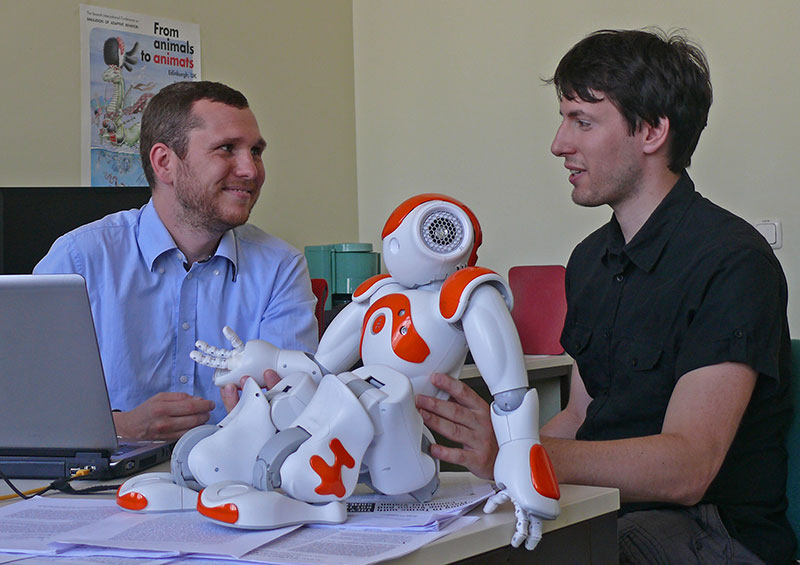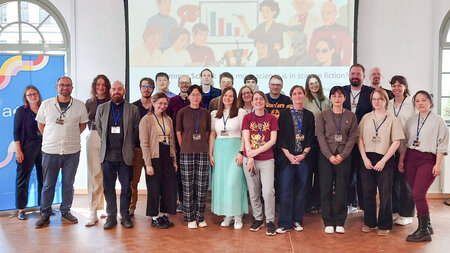Robot as a Social Being – How Does That Fit Together?
Andreas Bischof from the Professorship of Media Communication had a three-month stay in the USA conducting research on his PhD project at the CrossWorlds Research Training Group
-

Cooperation across disciplinary boundaries: Andreas Bischof (left) and Michael Teichmann from the Professorship of the Artificial Intelligence work together at the Crossworlds Research Training Group on the issue of what makes social robots social. Photo: Damaris Diener
The CrossWorlds Research Training Group exists since April 2012 at the Institute for Media Research and the Faculty of Computer Science at Technische Universität Chemnitz. Twelve PhD students are conducting their research there and deal with the link between virtual and real social worlds. One of them is Andreas Bischof, who studied Cultural Studies with a focus on Cultural Sociology. He holds a Bachelor`s and Master`s degree from Universität Leipzig, and now works at the Research Training Group in Chemnitz.
As part of his dissertation, which deals with the question of what requirements it takes to make a social robot really social, Bishop flew in March for three months to the United States. There he worked together with Robotics researchers at Carnegie Mellon University (Pittsburgh), the University of Washington (Seattle) and Yale University (New Haven). Prior to his stay in the USA, Bishop has already had the chance to meet international robot researchers in Netherlands, Denmark and Germany. “I am especially pleased that the exchange among researchers is collegial, and has often amicable relations over disciplinary boundaries. The researchers from the field of Robotics are usually very open-minded, curious, and really interested in the knowledge and methods from various areas,” said Bischof. The U.S. provided Bischof with an optimal research environment, as there are many universities now that are ranked in the technical and scientific fields at the international forefront. There is the National Robotics Initiative, a program for the academic and economic development of robots established since 2011.
But what makes a social robot really social? This question cannot yet be answered by Bischof conclusively, but it is certain that the various components such as the culture of the tray, the different disciplines involved, the everyday work of the researchers of the Robotics and the research funding play a role in this regard. “One of the key insights I`ve gained in the USA, is surely that a successful social robot must be constructed by researchers, having an above-average capacity for empathy, or in some cases even bring professional knowledge about certain social areas. A still tested thesis is whether this relates to the relatively high proportion of female researchers in this field,” said Bischof.
To make robots socially capable, at least in theory, exist two different technical approaches. First, there is the attempt to program the robots actual knowledge of certain social situations, which is demanding and often fails, if the robot leaves the lab and has to deal with real people.
A further possibility is to equip the robot with probability functions about the next human actions, in order to induce a “real” interaction. According to Bischof, this approach works in uncontrolled environments better than the first one, but there are many experiments needed in this field. “In addition to these challenges, there are the technical limitations such as battery life or physical appearance. So it will take a while until we can tell our roommate robot how was our working day like and how we are doing,” said Bischof. The Bischof is delighted by the research projects being attended in the USA, and praises their high level of quality. “I`m really glad that my postgraduate research group, the German Research Foundation and the German Academic Exchange Service, have made this experience possible. I am confident that the results will be of advantage to the colleagues here in Germany as well those living in the United States,” said Bischof.
(Author: Damaris Diener, Translation: Nataliia Boiko)
Katharina Thehos
27.06.2014




